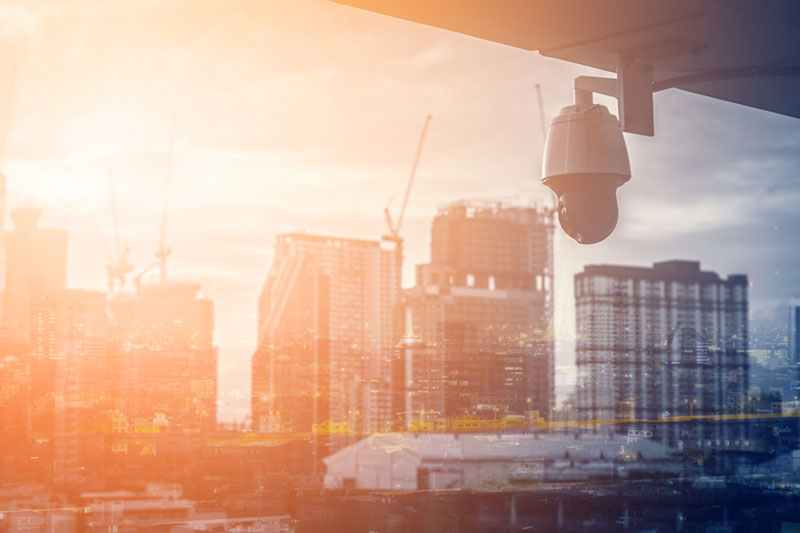 Securing construction sites has long been a challenge for developers in protecting the assets, safety, and delivery schedule of the construction process on their project job sites. Many of the tools, equipment, and materials used during the building process are expensive. If jobsites are unattended overnight or on weekends, this presents inherent risk, particularly as the prices of these materials rise. Protecting your construction crew, as well as their equipment, maintains the delivery schedule by avoiding unexpected delays. Trespassing and vandalism are also concerns. But low-cost methods of securing sites, like fencing and lighting, aren’t enough to deter all criminals and certainly don’t monitor site safety or construction progress. And hiring security personnel to patrol construction sites is costly, and not always effective, since guards can fall asleep, lose attention, or be in the wrong place when detrimental events occur.
Securing construction sites has long been a challenge for developers in protecting the assets, safety, and delivery schedule of the construction process on their project job sites. Many of the tools, equipment, and materials used during the building process are expensive. If jobsites are unattended overnight or on weekends, this presents inherent risk, particularly as the prices of these materials rise. Protecting your construction crew, as well as their equipment, maintains the delivery schedule by avoiding unexpected delays. Trespassing and vandalism are also concerns. But low-cost methods of securing sites, like fencing and lighting, aren’t enough to deter all criminals and certainly don’t monitor site safety or construction progress. And hiring security personnel to patrol construction sites is costly, and not always effective, since guards can fall asleep, lose attention, or be in the wrong place when detrimental events occur.
Furthermore, once a building’s development is complete, the strategy for securing it will shift. The property’s owners or managers could hire new guard staff or install a new video surveillance system, but this transition is disjoined and inherently wasteful, and is perhaps an unnecessary replacement project. It adds expenses and includes a great deal of repeated effort.
Why not streamline the process – increasing efficiencies and lowering costs – by using a single security solution throughout the building’s lifecycle, from construction through ongoing operations?
Remote guarding is more effective overall, and can flexibly accommodate the transition without replacement.
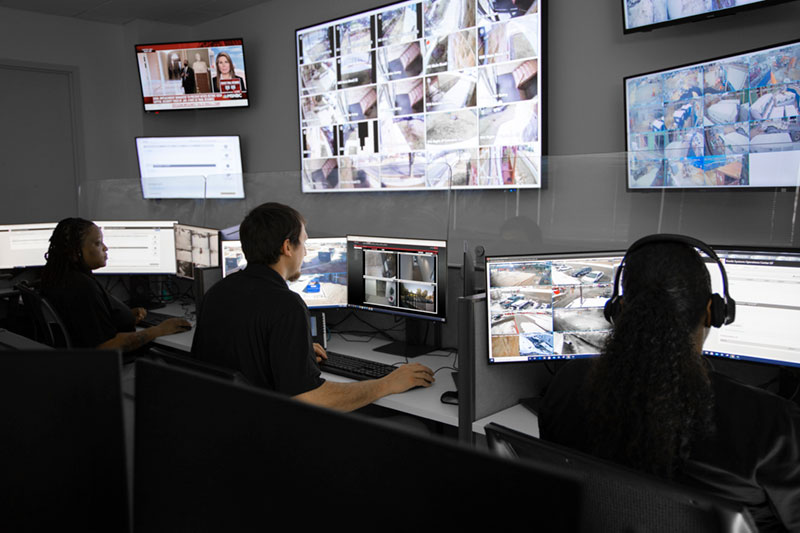 What is remote guarding?
What is remote guarding?
Remote guarding is a best-of-both-worlds approach that combines the efficiency, precision, and consistency of technology with the situational awareness and intelligence of live, real-time professional security experts on an as-needed basis. In remote guarding, smart video surveillance cameras constantly monitor for unusual activity based on digital algorithms. They’re intelligent enough to differentiate between innocuous and suspicious objects (so, for instance, they can tell when it’s a cat or a branch moving in the wind, and when there’s a human where there shouldn’t be one). If the software detects a threat, it triggers an alert to the operations center, where experts will review the video live stream to assess the validity of the threat. If it’s warranted, they can then apply live audio talk-down via on-site speakers or notify local law enforcement. If there’s no legitimate risk, no call will be made, avoiding false alarms that burden local police departments.
This combination of technology and human situational awareness reduces false alarm rates to near zero because trained experts always review the footage before initiating action.
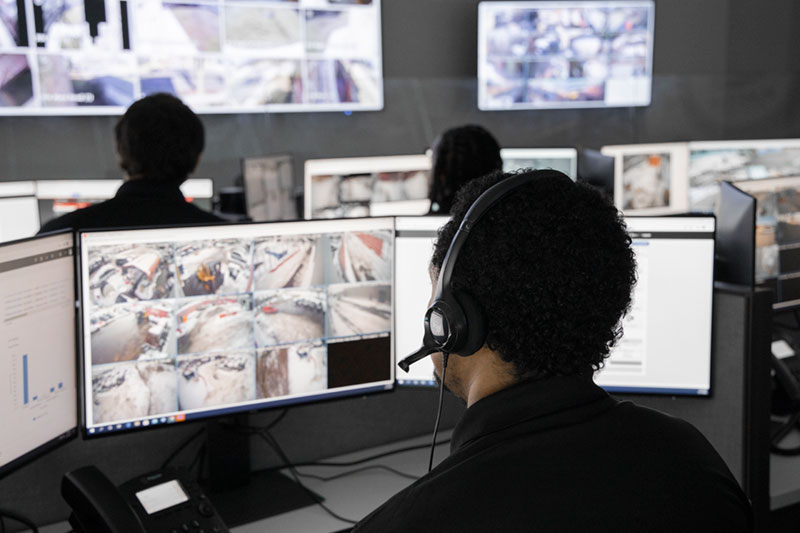 Benefits of remote guarding throughout the building lifecycle
Benefits of remote guarding throughout the building lifecycle
Remote guarding has multiple advantages over traditional surveillance methods, and these extend across the entirety of a building’s lifecycle. During construction – and later when the property is occupied – video monitoring can cover larger areas more quickly than human security guards. This enables more thorough surveillance with lower headcount. As a result, the property will be better protected against theft, vandalism, potential safety violations, misuse by visitors or residents, and other infractions. It can also record the daily progress of the construction process and keep digital video records.
As many as 95% of nationwide security system alarms turn out to be false, burdening police departments and reducing their ability to respond. Remote guarding shortens response times and improves accuracy. The technology is also readily scalable. There’s no limit on the number or type of properties a US-based remote video operations center can monitor for you. Buildings can be at any stage in construction or any level of occupancy.
Furthermore, remote guarding is very cost-efficient, especially when compared with alternatives. Setting up remote guarding involves a one-time capital investment only. If cameras are included in the initial building design, they can be leveraged throughout the building’s life. It’s simple to relocate cameras within the building or around the site as monitoring needs change over the course of development. Once you’ve established a relationship with a security partner to manage the solution, there are no additional implementation capital investment costs, unless you want to add more cameras. No need to worry about hassles or stumbling blocks because the system’s upkeep and ongoing maintenance are included in monthly subscription costs as a manageable operating expense.
Remote guarding makes securing properties near-effortless, but it’s also easy to employ it in other ways. The system can be leveraged to capture evidence for insurance or performance claims, for instance. Or you can use it to conduct safety audits remotely.
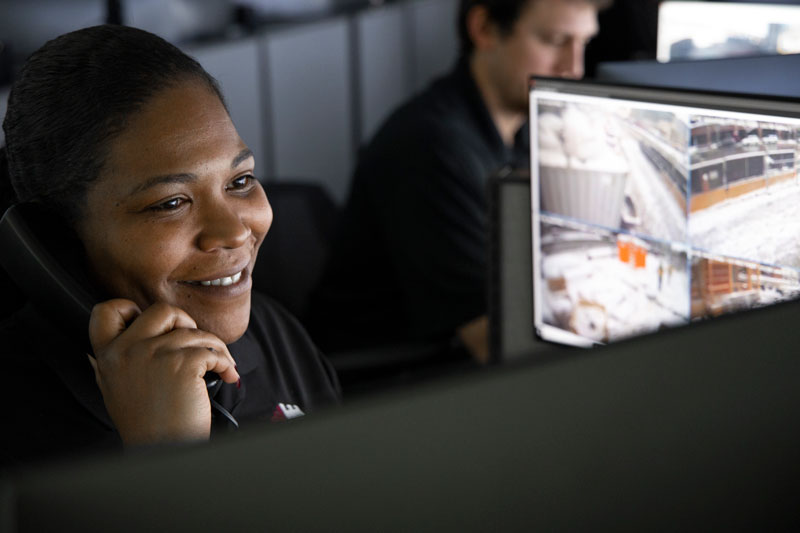 Look for a security partner who maintains a U.S.-based command center
Look for a security partner who maintains a U.S.-based command center
When you’re responding to a security incident, time is of the essence. That’s why it’s important to choose a security provider with a video monitoring center that’s based in the U.S. for your remote guarding solution. Some local law enforcement agencies will only dispatch officers if the alert comes from a domestic video monitoring system that’s UL-listed. This means that security companies that do monitoring offshore must turn over alert calls to a U.S.-based partner for additional validation before police can be notified. This process wastes precious time at a moment when every second matters.
Security experts in U.S.-based monitoring centers also have the cultural understanding to accurately interpret the severity of the threat that a particular perpetrator poses. And they can tailor their live talk- down messages to the situation, identifying suspects by their clothing, for instance, or reminding them that police are on the way. These experts also regularly review footage from the sites they monitor to find patterns or figure out if they can improve their effectiveness in future incidents.
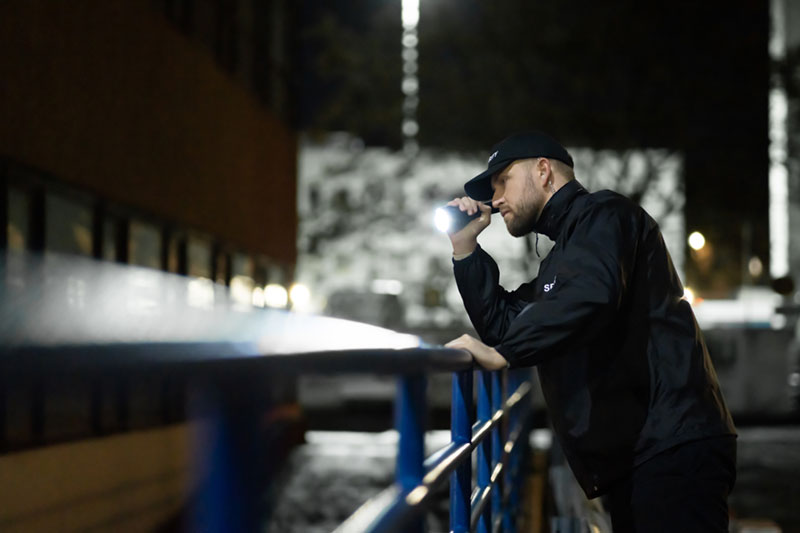 Remote guarding costs less than adding live, on-site guards
Remote guarding costs less than adding live, on-site guards
Whether you’re looking at offices, industrial space, or multifamily residential properties, commercial real estate is an attractive investment category. If you’re a developer or property owner, though, you’ll want to do everything you can to maximize the profitability of that investment. Eliminating inefficiencies and unnecessary expenses is key for ensuring that you’ll see a return on every dollar that you spend on your property.
Remote guarding has an important role to play in financially savvy real estate investment strategies. Both easy and affordable to install, remote guarding quickly pays for itself. Estimates show that remote video surveillance costs as much as 70% less than hiring an additional live guard. Furthermore, builders and property managers can strategically place cameras in multiple locations to cover more area across the property than security guards could. AI-enabled cameras have better vision than humans, and they never fall asleep or forget to pay attention. All this means that remote guarding can better reduce the risks to your commercial properties, and it can do so for less money.
This is why many insurers offer lower premiums for buildings that have remote guarding solutions in place. These cost savings can be realized both during construction and later on in the building’s lifecycle.
Cost savings aren’t the only benefit that real estate investors gain from remote guarding. The technology can centralize and consolidate the security and management of multiple properties. Whether you own many buildings or only a few, they can all be monitored by the same security provider, regardless of where the properties are located. This simplifies the task of monitoring an expanding or geographically diverse real estate portfolio.
If you’re a builder or developer who is planning to sell the property after construction is complete, you should know that the cost advantages of remote guarding can be very attractive to prospective buyers. Not only will they continue to enjoy the same accurate and thorough security coverage that the system provided while the building was being built, but they can readily adapt the solution for long-term use during occupancy. The same technology that can create a greater sense of safety among construction workers will give future occupants a better experience of living or working in the building.
Although this technology is already a powerful security tool, video analytics is constantly evolving and improving. Even as remote guarding continues to become more accurate and capable, it’s already offering developers and property managers alike the opportunity to keep buildings safe and secure in a way that’s efficient and cost-effective.
To learn more about how Kastle Security’s remote video guarding solutions can strengthen security without the cost of guards throughout a building’s lifecycle, check out our event-based video surveillance and live remote video patrol solutions.